Detection Method of Partial Discharge on Transformer and Gas-Insulated Switchgear: A Review
Abstract
1. Introduction
2. Method of PD Detection Based on Different Types of Signals Emitted during PD Activities
2.1. Electromagnetic Method
2.2. Electrical Method
2.3. Chemical Method
2.4. Acoustic Method
- Test Transformer: This is a specific type of transformer used for testing and monitoring purposes. It is designed to mimic the behavior of the power transformer under normal operating conditions;
- Transducer: The transducer is a device that converts the acoustic signals generated by the partial discharge events in the power transformer into electrical signals. It effectively picks up the acoustic emissions and transforms them into measurable electrical signals;
- Preamplifier: The electrical signals from the transducer are typically weak and need to be amplified for further processing. The preamplifier is responsible for boosting the weak signals to a level suitable for subsequent stages in the recording system;
- Track Signal and Filter: After amplification, the AE signals may contain unwanted noise or irrelevant frequencies. The track signal and filter stage are used to filter out unwanted frequencies and ensure that the signals of interest are properly isolated;
- Broadband Amplifier: The filtered AE signals are further amplified using a broadband amplifier. The amplifier boosts the desired AE signals to a level suitable for accurate measurement and analysis;
- Measurement and Card or Analyzer: This is the core component responsible for processing and analyzing the amplified AE signals. It may be a dedicated hardware card or a specialized analyzer device designed to detect and analyze AE signals from partial discharges;
- Computer: The final stage involves recording the processed AE signals on a computer for storage and further analysis. The computer may have specialized software to handle data logging, signal visualization, and in-depth analysis of the recorded AE signals.
2.5. Optical Method
2.6. Combinational Method
3. Type of Sensor Used to Detect PD Signals
3.1. Electrical–Electromagnetic Sensor
3.2. Acoustic Sensor
3.3. Optical Sensor
4. Partial Discharge Measurement Using Different Types of Sensors on the Power Transformer and GIS
4.1. Mechanism in Electric–Electromagnetic Sensors
4.1.1. PD Detection in Gas-Insulated Switchgear
4.1.2. PD Detection in Transformer
4.2. Mechanism in Chemical Sensors
PD Detection in Transformer
4.3. Mechanism in Acoustic Sensors
4.3.1. PD Detection in Gas-Insulated Switchgear
4.3.2. PD Detection in Transformer
4.4. Mechanism in Optical Sensors
PD Detection in Transformer
5. Challenges and Future Directions of PD Detection in Transformers and GIS
- i.
- Sensitivity and accuracy: One of the primary challenges is achieving high sensitivity and accuracy in PD detection. PD signals can be weak and easily masked by noise, making it challenging to detect and distinguish them from other signals. Future directions involve developing advanced signal processing techniques, pattern recognition algorithms, and machine learning approaches to enhance sensitivity and reduce false alarms.
- ii.
- Online monitoring: Currently, PD detection in transformers and GIS is predominantly performed through offline testing, which involves shutting down the equipment. However, there is a growing need for online monitoring systems that can continuously detect and monitor PD during normal operation. Future directions involve developing non-intrusive, online PD detection techniques that can provide real-time monitoring without disrupting the system.
- iii.
- Sensor placement and installation: Optimal sensor placement is crucial for effective PD detection. Transformers and GIS have complex structures, and it can be challenging to determine the best locations for sensors to capture PD signals accurately. Future directions involve conducting research on optimal sensor placement techniques using simulations, advanced modeling, and experimental studies to improve the reliability and sensitivity of PD detection.
- iv.
- UHF and optical methods: Ultra-High-Frequency (UHF) and optical methods are emerging as promising techniques for PD detection. UHF sensors can capture PD signals in the radio frequency range, while optical methods use fiber optic sensors for detection. These approaches offer advantages such as higher sensitivity, immunity to electromagnetic interference, and the ability to cover a large area. Future directions involve further developing and refining these techniques to make them more practical, cost-effective, and suitable for deployment in transformers and GIS.
- v.
- Condition monitoring and data analytics: PD detection is not limited to identifying the presence of PD; it also involves analyzing the data to assess the condition of the equipment. Future directions involve integrating PD detection with advanced data analytics, such as predictive maintenance and fault diagnosis algorithms. This will enable a better understanding of PD behavior, identification of potential failure modes, and timely decision making for maintenance and asset management.
- vi.
- Standardization and guidelines: Developing standardized procedures, guidelines, and best practices for PD detection in transformers and GIS is important for ensuring consistency and reliability across different utilities and industries. Future directions involve establishing international standards and guidelines based on extensive research, testing, and collaborative efforts among experts and industry stakeholders.
6. Conclusions
Author Contributions
Funding
Data Availability Statement
Acknowledgments
Conflicts of Interest
References
- Akbari, A.; Werle, P.; Borsi, H.; Gockenbach, E. Transfer function-based partial discharge localization in power transformers: A feasibility study. IEEE Electr. Insul. Mag. 2002, 18, 22–32. [Google Scholar] [CrossRef]
- Meira, M.; Ruschetti, C.R.; Álvarez, R.E.; Verucchi, C.J. Power transformers monitoring based on electrical measurements: State of the art. IET Gener. Transm. Distrib. 2018, 12, 2805–2815. [Google Scholar] [CrossRef]
- Abbasi, A.R.; Mahmoudi, M.R.; Avazzadeh, Z. Diagnosis and clustering of power transformer winding fault types by cross-correlation and clustering analysis of FRA results. IET Gener. Transm. Distrib. 2018, 12, 4301–4309. [Google Scholar] [CrossRef]
- Saponara, S.; Fanucci, L.; Bernardo, F.; Falciani, A. Predictive Diagnosis of High-Power Transformer Faults by Networking Vibration Measuring Nodes with Integrated Signal Processing. IEEE Trans. Instrum. Meas. 2016, 65, 1749–1760. [Google Scholar] [CrossRef]
- Duval, M. A review of faults detectable by gas-in-oil analysis in transformers. IEEE Electr. Insul. Mag. 2002, 18, 8–17. [Google Scholar] [CrossRef]
- Faiz, J.; Soleimani, M. Dissolved gas analysis evaluation in electric power transformers using conventional methods a review. IEEE Trans. Dielectr. Electr. Insul. 2017, 24, 1239–1248. [Google Scholar] [CrossRef]
- Kawaguchi, Y.; Yanabu, S. Partial-Discharge Measurement on High-Voltage Power Transformers. IEEE Trans. Power Appar. Syst. 1969, PAS-88, 1187–1194. [Google Scholar] [CrossRef]
- Zhang, S. Analysis of Some Measurement Issues in Bushing Power Factor Tests in the Field. IEEE Trans. Power Deliv. 2006, 21, 1350–1356. [Google Scholar] [CrossRef]
- Hashemnia, N.; Abu-Siada, A.; Islam, S. Detection of power transformer bushing faults and oil degradation using frequency response analysis. IEEE Trans. Dielectr. Electr. Insul. 2016, 23, 222–229. [Google Scholar] [CrossRef]
- Secic, A.; Krpan, M.; Kuzle, I. Vibro-Acoustic Methods in the Condition Assessment of Power Transformers: A Survey. IEEE Access 2019, 7, 83915–83931. [Google Scholar] [CrossRef]
- Wang, M.; Vandermaar, A.; Srivastava, K. Review of condition assessment of power transformers in service. IEEE Electr. Insul. Mag. 2002, 18, 12–25. [Google Scholar] [CrossRef]
- Oliveira, M.O.; Bretas, A.S. Application of Discrete Wavelet Transform for differential protection of power transformers. In Proceedings of the 2009 IEEE Bucharest PowerTech, Bucharest, Romania, 28 June–2 July 2009; pp. 1–8. [Google Scholar] [CrossRef]
- Yao, C.; Zhao, Z.; Mi, Y.; Li, C.; Liao, Y.; Qian, G. Improved Online Monitoring Method for Transformer Winding Deformations Based on the Lissajous Graphical Analysis of Voltage and Current. IEEE Trans. Power Deliv. 2015, 30, 1965–1973. [Google Scholar] [CrossRef]
- Saha, T.K. Review of modern diagnostic techniques for assessing insulation condition in aged transformers. IEEE Trans. Dielectr. Electr. Insul. 2003, 10, 903–917. [Google Scholar] [CrossRef]
- Cardoso, A.; Oliveira, L.M. Condition monitoring and diagnostics of power transformers. Int. J. COMADEM 1999, 2, 5–11. [Google Scholar]
- Tenbohlen, S.; Coenen, S.; Djamali, M.; Müller, A.; Samimi, M.H.; Siegel, M. Diagnostic Measurements for Power Trans-formers. Energies 2016, 9, 347. [Google Scholar] [CrossRef]
- Fu, Q.; Zhu, J.; Mao, Z.-H.; Zhang, G.; Chen, T. Online Condition Monitoring of Onboard Traction Transformer Core Based on Core-Loss Calculation Model. IEEE Trans. Ind. Electron. 2017, 65, 3499–3508. [Google Scholar] [CrossRef]
- Christina, A.; Salam, M.A.; Rahman, Q.M.; Wen, F.; Ang, S.P.; Voon, W. Causes of transformer failures and diagnostic methods—A review. Renew. Sustain. Energy Rev. 2018, 82, 1442–1456. [Google Scholar]
- Han, Y.; Song, Y. Condition monitoring techniques for electrical equipment-a literature survey. IEEE Trans. Power Deliv. 2003, 18, 4–13. [Google Scholar] [CrossRef]
- Bigdeli, M.; Vakilian, M.; Rahimpour, E. Transformer winding faults classification based on transfer function analysis by support vector machine. IET Electr. Power Appl. 2012, 6, 268–276. [Google Scholar] [CrossRef]
- Li, S.; Li, J. Condition monitoring and diagnosis of power equipment: Review and prospective. High Volt. 2017, 2, 82–91. [Google Scholar] [CrossRef]
- Medeiros, R.P.; Costa, F.B.; Silva, K.M. Power Transformer Differential Protection Using the Boundary Discrete Wavelet Transform. IEEE Trans. Power Deliv. 2015, 31, 2083–2095. [Google Scholar] [CrossRef]
- Fuhr, J. Procedure for identification and localization of dangerous PD sources in power transformers. IEEE Trans. Dielectr. Electr. Insul. 2005, 12, 1005–1014. [Google Scholar] [CrossRef]
- Bhatt, S.M.; Kumar, D.; Patel, K. Partial Discharge Analysis in Time and Time-Frequency Domain of Solid Dielectric in Power Transformer. In Proceedings of the 2018 5th IEEE Uttar Pradesh Section International Conference on Electrical, Electronics and Computer Engineering (UPCON), Gorakhpur, India, 2–4 November 2018; pp. 1–5. [Google Scholar] [CrossRef]
- Kumar, A.S.; Gupta, R.P.; Udayakumar, K.; Venkatasami, A. Online partial discharge detection and location techniques for condition monitoring of power transformers: A review. In Proceedings of the 2008 International Conference on Condition Monitoring and Diagnosis, Beijing, China, 21–24 April 2008; pp. 927–931. [Google Scholar] [CrossRef]
- Darwish, A.; Refaat, S.S.; Toliyat, H.A.; Abu-Rub, H. On the Electromagnetic Wave Behavior Due to Partial Discharge in Gas Insulated Switchgears: State-of-Art Review. IEEE Access 2019, 7, 75822–75836. [Google Scholar] [CrossRef]
- Liao, R.-J.; Yang, L.-J.; Li, J.; Grzybowski, S. Aging condition assessment of transformer oil-paper insulation model based on partial discharge analysis. IEEE Trans. Dielectr. Electr. Insul. 2011, 18, 303–311. [Google Scholar] [CrossRef]
- Fuhr, J.; Aschwanden, T. Identification and localization of PD-sources in power-transformers and power-generators. IEEE Trans. Dielectr. Electr. Insul. 2017, 24, 17–30. [Google Scholar] [CrossRef]
- Mor, A.R.; Heredia, L.C.; Harmsen, D.; Muñoz, F. A new design of a test platform for testing multiple partial discharge sources. Int. J. Electr. Power Energy Syst. 2018, 94, 374–384. [Google Scholar] [CrossRef]
- Rubio-Serrano, J.; Rojas-Moreno, M.V.; Posada, J.; Martínez-Tarifa, J.M.; Robles, G.; Garcia-Souto, J.A. Electro-acoustic detection, identification and location of partial discharge sources in oil-paper insulation systems. IEEE Trans. Dielectr. Electr. Insul. 2012, 19, 1569–1578. [Google Scholar] [CrossRef]
- Braunlich, R.; Hassig, M.; Fuhr, J.; Aschwanden, T. Assessment of insulation condition of large power transformers by on-site electrical diagnostic methods. In Proceedings of the Conference Record of the 2000 IEEE International Symposium on Electrical Insulation (Cat. No.00CH37075), Anaheim, CA, USA, 5 April 2000; pp. 368–372. [Google Scholar] [CrossRef]
- Yaacob, M.M.; Alsaedi, M.A.; Rashed, J.R.; Dakhil, A.M.; Atyah, S.F. Review on partial discharge detection techniques related to high voltage power equipment using different sensors. Photon-Sens. 2014, 4, 325–337. [Google Scholar] [CrossRef]
- Khan, Q.; Refaat, S.S.; Abu-Rub, H.; Toliyat, H.A. Partial discharge detection and diagnosis in gas insulated switchgear: State of the art. IEEE Electr. Insul. Mag. 2019, 35, 16–33. [Google Scholar] [CrossRef]
- Sinaga, H.H.; Phung, B.T.; Blackburn, T.R. Partial discharge localization in transformers using UHF detection method. IEEE Trans. Dielectr. Electr. Insul. 2012, 19, 1891–1900. [Google Scholar] [CrossRef]
- Chen, M.-K.; Chen, J.-M.; Cheng, C.-Y. Partial discharge detection by RF coil in 161 kV power transformer. IEEE Trans. Dielectr. Electr. Insul. 2014, 21, 1405–1414. [Google Scholar] [CrossRef]
- Jahangir, H.; Akbari, A.; Werle, P.; Szczechowski, J. UHF PD measurements on power transformers-advantages and limitations. IEEE Trans. Dielectr. Electr. Insul. 2017, 24, 3933–3940. [Google Scholar] [CrossRef]
- Ariannik, M.; Azirani, M.A.; Werle, P.; Azirani, A.A. UHF Measurement in Power Transformers: An Algorithm to Optimize Accuracy of Arrival Time Detection and PD Localization. IEEE Trans. Power Deliv. 2019, 34, 1530–1539. [Google Scholar] [CrossRef]
- Beura, C.P.; Beltle, M.; Tenbohlen, S. Positioning of UHF PD Sensors on Power Transformers Based on the Attenuation of UHF Signals. IEEE Trans. Power Deliv. 2019, 34, 1520–1529. [Google Scholar] [CrossRef]
- Biswas, S.; Koley, C.; Chatterjee, B.; Chakravorti, S. A methodology for identification and localization of partial discharge sources using optical sensors. IEEE Trans. Dielectr. Electr. Insul. 2012, 19, 18–28. [Google Scholar] [CrossRef]
- Razzaq, A.; Zainuddin, H.; Hanaffi, F.; Chyad, R.M. Transformer oil diagnostic by using an optical fibre system: A review. IET Sci. Meas. Technol. 2019, 13, 615–621. [Google Scholar] [CrossRef]
- Baug, A.; Choudhury, N.R.; Ghosh, R.; Dalai, S.; Chatterjee, B. Identification of single and multiple partial discharge sources by optical method using mathematical morphology aided sparse representation classifier. IEEE Trans. Dielectr. Electr. Insul. 2017, 24, 3703–3712. [Google Scholar] [CrossRef]
- Refaat, S.S.; Sayed, M.; Shams, M.A.; Mohamed, A. A review of partial discharge detection techniques in power transformers. In Proceedings of the 2018 Twentieth International Middle East Power Systems Conference (MEPCON), Cairo, Egypt, 18–20 December 2018. [Google Scholar] [CrossRef]
- Hooshmand, R.A.; Parastegari, M.; Yazdanpanah, M. Simultaneous location of two partial discharge sources in power transformers based on acoustic emission using the modified binary partial swarm optimisation algorithm. IET Sci. Meas. Technol. 2013, 7, 119–127. [Google Scholar] [CrossRef]
- Wang, Y.B.; Fan, Y.H.; Qin, S.R.; Chang, D.G.; Shao, X.J.; Mu, H.B.; Zhang, G.J. Partial discharge localisation methodology for power transformers based on improved acoustic propagation route search algorithm. IET Sci. Meas. Technol. 2018, 12, 1023–1030. [Google Scholar] [CrossRef]
- Shanker, T.B.; Nagamani, H.N.; Antony, D.; Punekar, G.S. Effects of Transformer-Oil Temperature on Amplitude and Peak Frequency of Partial Discharge Acoustic Signals. IEEE Trans. Power Deliv. 2018, 33, 3227–3229. [Google Scholar] [CrossRef]
- Wang, Y.-B.; Chang, D.-G.; Fan, Y.-H.; Zhang, G.-J.; Zhan, J.-Y.; Shao, X.-J.; He, W.-L. Acoustic localization of partial discharge sources in power transformers using a particle-swarm-optimization-route-searching algorithm. IEEE Trans. Dielectr. Electr. Insul. 2017, 24, 3647–3656. [Google Scholar] [CrossRef]
- Dai, J.; Song, H.; Sheng, G.; Jiang, X. Dissolved gas analysis of insulating oil for power transformer fault diagnosis with deep belief network. IEEE Trans. Dielectr. Electr. Insul. 2017, 24, 2828–2835. [Google Scholar] [CrossRef]
- Mackenzie, E.; Crossey, J.; DePablo, A.; Ferguson, W. On-line monitoring and diagnostics for power transformers. In Proceedings of the 2010 IEEE International Symposium on Electrical Insulation, San Diego, CA, USA, 6–9 June 2010; IEEE: New York, NY, USA, 2010. [Google Scholar]
- Faiz, J.; Soleimani, M. Assessment of computational intelligence and conventional dissolved gas analysis methods for transformer fault diagnosis. IEEE Trans. Dielectr. Electr. Insul. 2018, 25, 1798–1806. [Google Scholar] [CrossRef]
- Wang, X.; Li, B.; Roman, H.; Russo, O.; Chin, K.; Farmer, K. Acousto-optical PD Detection for Transformers. IEEE Trans. Power Deliv. 2006, 21, 1068–1073. [Google Scholar] [CrossRef]
- Si, W.; Fu, C.; Yuan, P. An Integrated Sensor With AE and UHF Methods for Partial Discharges Detection in Transformers Based on Oil Valve. IEEE Sens. Lett. 2019, 3, 1–3. [Google Scholar] [CrossRef]
- Lu, Y.; Qiu, Z.; Liao, C.; Li, T.; Wu, Z.; Hu, Y. The Application of High Frequency and Ultra High Frequency Partial Discharge Detection to Gas Insulated Switchgear. In Proceedings of the 2022 4th Asia Energy and Electrical Engineering Symposium (AEEES), Chengdu, China, 25–28 March 2022; pp. 712–716. [Google Scholar] [CrossRef]
- Sinaga, H.; Phung, B.; Blackburn, T. Partial discharge measurement for transformer insulation using wide and narrow band methods in ultra high frequency range. In Proceedings of the 2009 Australasian Universities Power Engineering Conference, Adelaide, Australia, 27–30 September 2009; IEEE: New York, NY, USA, 2010. [Google Scholar]
- Shi, R.; Li, S.; Li, Q.; Liu, B.; Ma, S.; Wu, L. The application of transient earth voltage in the partial discharge of power transformers. In Proceedings of the 2017 1st International Conference on Electrical Materials and Power Equipment (ICEMPE), Xi’an, China, 14–17 May 2017; pp. 202–206. [Google Scholar] [CrossRef]
- Ren, M.; Dong, M.; Ren, Z.; Li, H.; Qiu, A. Application of Transient Earth Voltage method in PD detection in GIS. In Proceedings of the 2011 International Symposium on Electrical Insulating Materials, Kyoto, Japan, 6–10 September 2011; IEEE: New York, NY, USA, 2010. [Google Scholar]
- Nagamani, H.N.; Shanker, T.B.; Vaidhyanathan, V.; Neelakantan, S. Acoustic emission technique for detection and location of simulated defects in power transformers. In Proceedings of the 2005 IEEE Russia Power Tech, St. Petersburg, Russia, 27–30 June 2005; pp. 1–7. [Google Scholar] [CrossRef]
- Qi, B.; Li, C.; Hao, Z.; Geng, B.; Xu, D.; Liu, S.; Deng, C. Partial discharge detection for GIS: A comparison between UHF and acoustic methods. In Proceedings of the 2010 IEEE International Symposium on Electrical Insulation, San Diego, CA, USA, 6–9 June 2010; pp. 1–5. [Google Scholar] [CrossRef]
- Rutgers, W.R.; Fu, Y.H. UHF PD-Detection in a power transformer. In Proceedings of the 10th International Symposium on High Voltage Engineering, Montreal, QC, Canada, 24–30 August 1997; pp. 219–222. [Google Scholar]
- Wiesbeck, W.; Sturm, C.; Soergel, W.; Porebska, M.; Adamiuk, G. Influence of Antenna Performance and Propagation Channel on Pulsed UWB Signals. In Proceedings of the 2007 International Conference on Electromagnetics in Advanced Applications, Turin, Italy, 17–21 September 2007; pp. 915–922. [Google Scholar] [CrossRef]
- Jiang, T.; Li, J.; Zheng, Y.; Sun, C. Improved Bagging Algorithm for Pattern Recognition in UHF Signals of Partial Discharges. Energies 2011, 4, 1087–1101. [Google Scholar] [CrossRef]
- Judd, M.D.; Yang, L.; Hunter, I. Partial discharge monitoring for power transformer using UHF sensors. Part 2: Field experience. IEEE Electr. Insul. Mag. 2005, 21, 5–13. [Google Scholar] [CrossRef]
- Judd, M.D.; Yang, L.; Hunter, I. Partial discharge monitoring of power transformers using UHF sensors. Part I: Sensors and signal interpretation. IEEE Electr. Insul. Mag. 2005, 21, 5–14. [Google Scholar] [CrossRef]
- Jahangir, H.; Akbari, A.; Werle, P.; Szczechowski, J. Possibility of PD calibration on power transformers using UHF probes. IEEE Trans. Dielectr. Electr. Insul. 2017, 24, 2968–2976. [Google Scholar] [CrossRef]
- Gaouda, A.M.; El-Hag, A.; Abdel-Galil, T.K.; Salama, M.M.; Bartnikas, R. On-line detection and measurement of partial discharge signals in a noisy environment. IEEE Trans. Dielectr. Electr. Insul. 2008, 15, 1162–1173. [Google Scholar] [CrossRef]
- Seo, J.; Ma, H.; Saha, T.K. A Joint Vibration and Arcing Measurement System for Online Condition Monitoring of Onload Tap Changer of the Power Transformer. IEEE Trans. Power Deliv. 2016, 32, 1031–1038. [Google Scholar] [CrossRef]
- Rahman, M.S.A.; Lewin, P.L.; Rapisarda, P. Autonomous localization of partial discharge sources within large transformer windings. IEEE Trans. Dielectr. Electr. Insul. 2016, 23, 1088–1098. [Google Scholar] [CrossRef]
- Timperley, J.E. Incipient fault identification through neutral RF monitoring of large rotating machines. IEEE Trans. Power Appar. Syst. 1983, 3, 693–698. [Google Scholar] [CrossRef]
- Giussani, R.; Cotton, I.; Sloan, R. Comparison of IEC 60270 and RF partial discharge detection in an electromagnetic noise-free environment at differing pressures. In Proceedings of the 2012 IEEE International Symposium on Electrical Insulation, San Juan, PR, USA, 10–13 June 2012; pp. 127–131. [Google Scholar] [CrossRef]
- IEEE Standard C57.113-2010 (Revision IEEE Standard C57.113-1991); IEEE Recommended Practice for Partial Discharge Measurement in Liquid-Filled Power Transformers and Shunt Reactors. IEEE: Piscataway, NJ, USA, 2010; pp. 1–47.
- Judd, M.D. Experience with UHF partial discharge detection and location in power transformers. In Proceedings of the 2011 Electrical Insulation Conference (EIC), Annapolis, MD, USA, 5–8 June 2011; IEEE: New York, NY, USA, 2011. [Google Scholar]
- IEC Int. Standard 60270; 3rd ed. High Voltage Test Techniques-Partial Discharge Measurements. IEC: Geneva, Switzerland, 2000.
- Xie, Q.; Cheng, S.; Lü, F.; Li, Y. Location of partial discharge in transformer oil using circular array of ultrasonic sensors. IEEE Trans. Dielectr. Electr. Insul. 2013, 20, 1683–1690. [Google Scholar] [CrossRef]
- Zheng, S.; Li, C.; Tang, Z.; Chang, W.; He, M. Location of PDs inside transformer windings using UHF methods. IEEE Trans. Dielectr. Electr. Insul. 2014, 21, 386–393. [Google Scholar] [CrossRef]
- Bartnikas, R. Partial discharges. Their mechanism, detection and measurement. IEEE Trans. Dielectr. Electr. Insul. 2002, 9, 763–808. [Google Scholar] [CrossRef]
- Karmakar, S.; Roy, N.K.; Kumbhakar, P. Partial discharge measurement of transformer with ICT facilities. In Proceedings of the 2009 International Conference on Power Systems, Kharagpur, India, 27–29 December 2009; pp. 1–5. [Google Scholar] [CrossRef]
- Ma, G.M.; Li, C.R.; Mu, R.D.; Jiang, J.; Luo, Y.T. Fiber Bragg grating sensor for hydrogen detection in power transformers. IEEE Trans. Dielectr. Electr. Insul. 2014, 21, 380–385. [Google Scholar] [CrossRef]
- Skelly, D. Photo-acoustic spectroscopy for dissolved gas analysis: Benefits and Experience. In Proceedings of the 2012 IEEE International Conference on Condition Monitoring and Diagnosis, Bali, Indonesia, 23–27 September 2012; pp. 29–43. [Google Scholar] [CrossRef]
- Lima, S.E.U.; Frazao, O.; Farias, R.G.; Araujo, F.M.; Ferreira, L.A.; Santos, J.L.; Miranda, V. Mandrel-Based Fiber-Optic Sensors for Acoustic Detection of Partial Discharges—A Proof of Concept. IEEE Trans. Power Deliv. 2010, 25, 2526–2534. [Google Scholar] [CrossRef]
- Sheng, J.; Wu, G.; Tong, L.; Zhou, L.; Zhang, J. Study on gas and oil separating plant used for online monitoring system of transformer. In Proceedings of the Conference Record of the 2004 IEEE International Symposium on Electrical Insulation, Indianapolis, IN, USA, 19–22 September 2004. [Google Scholar] [CrossRef]
- Sparkman, O.D.; Penton, Z.; Kitson, F.G. Gas Chromatography and Mass Spectrometry: A Practical Guide; Academic Press: Cambridge, MA, USA, 2011. [Google Scholar]
- Bakar, N.; Abu-Siada, A.; Islam, S. A review of dissolved gas analysis measurement and interpretation techniques. IEEE Electr. Insul. Mag. 2014, 30, 39–49. [Google Scholar] [CrossRef]
- Jiang, J.; Song, H.T.; Ma, G.M.; Li, C.R.; Luo, Y.T.; Wang, H.B. Dissolved hydrogen detection in power transformer based on etched fiber Bragg grating. In Proceedings of the 2015 IEEE International Instrumentation and Measurement Technology Conference (I2MTC) Proceedings, Pisa, Italy, 11–14 May 2015; IEEE: New York, NY, USA, 2015. [Google Scholar]
- Mukhtaruddin, A.; Isa, M.; Adzman, M.R.; Hasan, S.I.S.; Rohani, M.N.K.H.; Yii, C.C. Techniques on partial discharge detection and location determination in power transformer. In Proceedings of the 2016 3rd International Conference on Electronic Design (ICED), Phuket, Thailand, 11–12 August 2016; pp. 537–542. [Google Scholar] [CrossRef]
- Mak, T.; Westerwaal, R.; Slaman, M.; Schreuders, H.; van Vugt, A.; Victoria, M.; Boelsma, C.; Dam, B. Optical fiber sensor for the continuous monitoring of hydrogen in oil. Sens. Actuators B Chem. 2014, 190, 982–989. [Google Scholar] [CrossRef]
- Kalathiripi, H.; Karmakar, S. Partial discharge study in transformer oil using acoustic emission technique and UV-visible spectroscopy. In Proceedings of the 2017 3rd International Conference on Condition Assessment Techniques in Electrical Systems (CATCON), Rupnagar, India, 16–18 November 2017; pp. 361–366. [Google Scholar] [CrossRef]
- Qian, S.; Chen, H.; Xu, Y.; Su, L. High sensitivity detection of partial discharge acoustic emission within power transformer by sagnac fiber optic sensor. IEEE Trans. Dielectr. Electr. Insul. 2018, 25, 2313–2320. [Google Scholar] [CrossRef]
- Kweon, D.-J.; Chin, S.-B.; Kwak, H.-R.; Kim, J.-C.; Song, K.-B. The Analysis of Ultrasonic Signals by Partial Discharge and Noise From the Transformer. IEEE Trans. Power Deliv. 2005, 20, 1976–1983. [Google Scholar] [CrossRef]
- Boczar, T.; Cichon, A.; Borucki, S. Diagnostic expert system of transformer insulation systems using the acoustic emission method. IEEE Trans. Dielectr. Electr. Insul. 2014, 21, 854–865. [Google Scholar] [CrossRef]
- Kucera, M.; Jarina, R.; Brncal, P.; Gutten, M. Visualisation and Measurement of Acoustic Emission from Power Transformers. In Proceedings of the 2019 12th International Conference on Measurement, Smolenice, Slovakia, 27–29 May 2019. [Google Scholar] [CrossRef]
- Kim, D.-G.; Sampath, U.; Kim, H.; Song, M. A fiber optic multi-stress monitoring system for power transformer. In Proceedings of the 2017 25th Optical Fiber Sensors Conference (OFS), Jeju, Korea, 24–28 April 2017. [Google Scholar] [CrossRef]
- Sikorski, W.; Siodla, K.; Moranda, H.; Ziomek, W. Location of partial discharge sources in power transformers based on advanced auscultatory technique. IEEE Trans. Dielectr. Electr. Insul. 2012, 19, 1948–1956. [Google Scholar] [CrossRef]
- Sarkar, B.; Koley, C.; Roy, N.; Kumbhakar, P. Condition monitoring of high voltage transformers using Fiber Bragg Grating Sensor. Measurement 2015, 74, 255–267. [Google Scholar] [CrossRef]
- Zhou, J.; Zhu, M.; Yun, Y.; Tao, J.; Liu, F. Partial Discharge Optical Pulse Signal Characteristics for Corona Defect in Oil Immersed Transformer. Res. J. Appl. Sci. Eng. Technol. 2013, 5, 3052–3056. [Google Scholar] [CrossRef]
- Fabian, J.; Neuwersch, M.; Sumereder, C.; Muhr, M.; Schwarz, R. State of the Art and Future Trends of Unconventional PD-Measurement at Power Transformers. J. Energy Power Eng. 2014, 8, 1093–1098. [Google Scholar] [CrossRef][Green Version]
- Shanker, T.B.; Vaidhyanathan, V.; Mohamed, A.S. Comparison of Partial Discharge Performance of Identical Generator Transformers in a Thermal Power Station by Acoustic Emission Technique—Case Studies. In Proceedings of the 2019 International Conference on High Voltage Engineering and Technology (ICHVET), Hyderabad, India, 7–8 February 2019; pp. 1–5. [Google Scholar] [CrossRef]
- Qi, Z.; Yi, Y.; Qiaohua, W.; Zhihao, W.; Zhe, L. Study on the Online Dissolved Gas Analysis Monitor based on the Photoacoustic Spectroscopy. In Proceedings of the 2012 IEEE International Conference on Condition Monitoring and Diagnosis, Bali, Indonesia, 23–27 September 2012; pp. 433–436. [Google Scholar] [CrossRef]
- Yongfen, L.; Xiaohu, X.; Fei, D.; Xiao, T.; Yanming, L. Comparison of DOA Algorithms Applied to Ultrasonic Arrays for PD Location in Oil. IEEE Sens. J. 2014, 15, 2316–2323. [Google Scholar] [CrossRef]
- Kim, Y.-J.; Hikita, M. A proposal for hybrid PD sensor identifying absolute distance from PD source. In Proceedings of the 2013 Annual Report Conference on Electrical Insulation and Dielectric Phenomena, Chenzhen, China, 20–23 October 2013; IEEE: New York, NY, USA, 2013. [Google Scholar]
- Hauschild, W.; Lemke, E. High-Voltage Test and Measuring Techniques; Springer: Berlin/Heidelberg, Germany, 2014; Volume 1. [Google Scholar]
- Kraetge, A.; Hoek, S.; Koch, M.; Koltunowicz, W. Robust measurement, monitoring and analysis of partial discharges in transformers and other HV apparatus. IEEE Trans. Dielectr. Electr. Insul. 2013, 20, 2043–2051. [Google Scholar] [CrossRef]
- Yin, Z.; Zhang, R.; Tong, J.; Chen, X. An all-fiber partial discharge monitoring system based on both intrinsic fiber optic interferometry sensor and fluorescent fiber. In Proceedings of the 2013 International Conference on Optical Instruments and Technology: Optical Sensors and Applications, Beijing, China, 20 December 2013. [Google Scholar] [CrossRef]
- Singsathien, J.; Suwanasri, T.; Suwanasri, C.; Ruankon, S.; Fuangpian, P.; Namvong, W.; Saengsaikaew, P.; Khotsang, W. Partial discharge detection and localization of defected power cable using HFCT and UHF sensors. In Proceedings of the 2017 14th International Conference on Electrical Engineering/Electronics, Computer, Telecommunications and Information Technology (ECTI-CON), Phuket, Thailand, 27–30 June 2017; IEEE: New York, NY, USA, 2017. [Google Scholar] [CrossRef]
- Kusumoto, S.; Itoh, S.; Tsuchiya, Y.; Mukae, H.; Matsuda, S.; Takahashi, K. Diagnostic Technique of Gas Insulated Substation by Partial Discharge Detection. IEEE Trans. Power Appar. Syst. 1980, PAS-99, 1456–1465. [Google Scholar] [CrossRef]
- Ilkhechi, H.D.; Samimi, M.H. Applications of the Acoustic Method in Partial Discharge Measurement: A Review. IEEE Trans. Dielectr. Electr. Insul. 2021, 28, 42–51. [Google Scholar] [CrossRef]
- Schwarz, R.; Muhr, M.; Pack, S. Partial discharge detection in oil with optical methods. In Proceedings of the IEEE International Conference on Dielectric Liquids, 2005. ICDL, Coimbra, Portugal, 26 June–1 July 2005; pp. 245–248. [Google Scholar] [CrossRef]
- Chai, H.; Phung, B.; Mitchell, S. Application of UHF Sensors in Power System Equipment for Partial Discharge Detection: A Review. Sensors 2019, 19, 1029. [Google Scholar] [CrossRef]
- Markalous, S.M.; Tenbohlen, S.; Feser, K. Detection and location of partial discharges in power transformers using acoustic and electromagnetic signals. IEEE Trans. Dielectr. Electr. Insul. 2008, 15, 1576–1583. [Google Scholar] [CrossRef]
- Pinpart, T.; Judd, M.D. Experimental comparison of UHF sensor types for PD location applications. In Proceedings of the 2009 IEEE Electrical Insulation Conference, Montreal, QC, Canada, 31 May–3 June 2009; pp. 26–30. [Google Scholar] [CrossRef]
- Tian, Y.; Lewin, P.; Davies, A. Comparison of on-line partial discharge detection methods for HV cable joints. IEEE Trans. Dielectr. Electr. Insul. 2002, 9, 604–615. [Google Scholar] [CrossRef]
- Dukes, R.; Culpan, E. Acoustic emission: Its techniques and applications. IEE Proc. A Phys. Sci. Meas. Instrum. Manag. Educ. Rev. 1984, 131, 241–251. [Google Scholar] [CrossRef]
- Lamela-Rivera, H.; Sanahuja, C.M.; García-Souto, J.A. Detection and wavelet analysis of partial discharges using an optical fibre interferometric sensor for high-power transformers. J. Opt. A Pure Appl. Opt. 2002, 5, 66–72. [Google Scholar] [CrossRef]
- Cosgrave, J.; Vourdas, A.; Jones, G.; Spencer, J.; Murphy, M.; Wilson, A. Acoustic monitoring of partial discharges in gas insulated substations using optical sensors. IEE Proc. A Sci. Meas. Technol. 1993, 140, 369–374. [Google Scholar] [CrossRef]
- Deng, J.; Xiao, H.; Huo, W.; Luo, M.; May, R.; Wang, A.; Liu, Y. Optical fiber sensor-based detection of partial discharges in power transformers. Opt. Laser Technol. 2001, 33, 305–311. [Google Scholar] [CrossRef]
- Gorablenkow, J.; Huecker, T.; Schichler, U. Application of UHF partial discharge monitoring and expert system diagnosis. In Proceedings of the Conference Record of the 1998 IEEE International Symposium on Electrical Insulation (Cat. No. 98CH36239), Arlington, VA, USA, 7–10 June 1998; Volume 1, pp. 61–64. [Google Scholar] [CrossRef]
- Judd, M.D.; Farish, O. High bandwidth measurement of partial discharge current pulses. In Proceedings of the Conference Record of the 1998 IEEE International Symposium on Electrical Insulation (Cat. No. 98CH36239), Arlington, VA, USA, 7–10 June 1998; Volume 2, pp. 436–439. [Google Scholar] [CrossRef]
- Nattrass, D. Partial discharge measurement and interpretation. IEEE Electr. Insul. Mag. 1988, 4, 10–23. [Google Scholar] [CrossRef]
- Negm, T.S.; Refaey, M.; Hossam-Eldin, A.A. Modeling and simulation of internal Partial Discharges in solid dielectrics under variable applied frequencies. In Proceedings of the 2016 Eighteenth International Middle East Power Systems Conference (MEPCON), Cairo, Egypt, 27–29 December 2017; pp. 639–644. [Google Scholar] [CrossRef]
- Korobeynikov, S.; Ovsyannikov, A.; Ridel, A.; Karpov, D.; Lyutikova, M.; Kuznetsova, Y.; Yassinskiy, V. Study of partial discharges in liquids. J. Electrost. 2019, 103, 103412. [Google Scholar] [CrossRef]
- Montanari, G.C. On line partial discharge diagnosis of power cables. In Proceedings of the 2009 IEEE Electrical Insulation Conference, Montreal, QC, Canada, 31 May–3 June 2009; pp. 210–215. [Google Scholar] [CrossRef]
- Sarathi, R.; Giridhar, A.; Sethupathi, K. Analysis of partial discharge activity by a conducting particle in liquid nitrogen under AC voltages adopting UHF technique. Cryogenics 2010, 50, 43–49. [Google Scholar] [CrossRef]
- Shen, Z.; El-Saadany, E. Localization of partial discharges using UHF sensors in power transformers. In Proceedings of the 2006 IEEE Power Engineering Society General Meeting, Montreal, QC, Canada, 18–22 June 2006. [Google Scholar] [CrossRef]
- Kemp, I. Partial discharge plant-monitoring technology: Present and future developments. IEE Proc.-Sci. Meas. Technol. 1995, 142, 4–10. [Google Scholar] [CrossRef]
- Kil, G.-S.; Kim, I.K.; Park, D.-W.; Choi, S.-Y.; Park, C.-Y. Measurements and analysis of the acoustic signals produced by partial discharges in insulation oil. Curr. Appl. Phys. 2008, 9, 296–300. [Google Scholar] [CrossRef]
- Schwarz, R.; Judendorfer, T.; Muhr, M. Review of partial discharge monitoring techniques used in high voltage equipment. In Proceedings of the 2008 Annual Report Conference on Electrical Insulation and Dielectric Phenomena, Quebec, QC, Canada, 26–29 October 2008; IEEE: New York, NY, USA, 2008. [Google Scholar]
- Macià-Sanahuja, C.; Lamela, H.; García-Souto, J.A. Fiber optic interferometric sensor for acoustic detection of partial discharges. J. Opt. Technol. 2007, 74, 122–126. [Google Scholar] [CrossRef]
- Claus, R.O.; Gunther, M.F.; Wang, A.; Murphy, K.A. Extrinsic Fabry-Perot sensor for strain and crack opening displacement measurements from −200 to 900 degrees C. Smart Mater. Struct. 1992, 1, 237–242. [Google Scholar] [CrossRef]
- Belanger, G.; Duval, M. Monitor for Hydrogen Dissolved in Transformer Oil. IEEE Trans. Electr. Insul. 1977, EI-12, 334–340. [Google Scholar] [CrossRef]
- Zhu, M.-X.; Wang, Y.-B.; Chang, D.-G.; Zhang, G.-J.; Shao, X.-J.; Zhan, J.-Y.; Chen, J.-M. Discrimination of three or more partial discharge sources by multi-step clustering of cumulative energy features. IET Sci. Meas. Technol. 2019, 13, 149–159. [Google Scholar] [CrossRef]
- Ozgonenel, O.; Karagol, S. Power transformer protection based on decision tree approach. IET Electr. Power Appl. 2014, 8, 251–256. [Google Scholar] [CrossRef]
- Wu, M.; Cao, H.; Cao, J.; Nguyen, H.-L.; Gomes, J.B.; Krishnaswamy, S.P. An overview of state-of-the-art partial discharge analysis techniques for condition monitoring. IEEE Electr. Insul. Mag. 2015, 31, 22–35. [Google Scholar] [CrossRef]
- Zhou, H.-Y.; Ma, G.-M.; Qin, W.-Q.; Zhang, M.; Zhang, Q.; Lin, Z.-Q.; Jiang, J. A Multiplexing Optical Partial Discharge Sensing System for Power Transformer Using a Single Photodetector. IEEE Trans. Power Deliv. 2021, 36, 1911–1913. [Google Scholar] [CrossRef]
- Zhou, H.-Y.; Ma, G.-M.; Zhang, M.; Zhang, H.-C.; Li, C.-R. A High Sensitivity Optical Fiber Interferometer Sensor for Acoustic Emission Detection of Partial Discharge in Power Transformer. IEEE Sens. J. 2019, 21, 24–32. [Google Scholar] [CrossRef]
- Sharifinia, S.; Allahbakhshi, M.; Ghanbari, T.; Akbari, A.; Mirzaei, H.R. A New Application of Rogowski Coil Sensor for Partial Discharge Localization in Power Transformers. IEEE Sens. J. 2021, 21, 10743–10751. [Google Scholar] [CrossRef]
- Hashim, A.H.M.; Azis, N.; Jasni, J.; Radzi, M.A.M.; Masahiro, K.; Kamarol, M.; Yaakub, Z. Partial Discharge Localization in Oil through Acoustic Emission Technique Utilizing Fuzzy Logic. IEEE Trans. Dielectr. Electr. Insul. 2022, 29, 623–630. [Google Scholar] [CrossRef]
- Li, J.; Han, X.; Liu, Z.; Yao, X. A Novel GIS Partial Discharge Detection Sensor With Integrated Optical and UHF Methods. IEEE Trans. Power Deliv. 2016, 33, 2047–2049. [Google Scholar] [CrossRef]
- Wu, Z.; Zhang, Q.; Ma, J.; Li, X.; Wen, T. Effectiveness of on-site dielectric test of GIS equipment. IEEE Transactions on Dielectrics and Electrical Insulation. IEEE Trans. Dielectr. Electr. Insul. 2018, 25, 1454–1460. [Google Scholar] [CrossRef]
- Kim, S.-W.; Jung, J.-R.; Kim, Y.-M.; Kil, G.-S.; Wang, G. New diagnosis method of unknown phase-shifted PD signals for gas insulated switchgears. IEEE Trans. Dielectr. Electr. Insul. 2018, 25, 102–109. [Google Scholar] [CrossRef]
- Ma, G.-M.; Zhou, H.-Y.; Zhang, M.; Li, C.-R.; Yin, Y.; Wu, Y.-Y. A High Sensitivity Optical Fiber Sensor for GIS Partial Discharge Detection. IEEE Sens. J. 2019, 19, 9235–9243. [Google Scholar] [CrossRef]
- Thi, N.-D.T.; Do, T.-D.; Jung, J.-R.; Jo, H.; Kim, Y.-H. Anomaly Detection for Partial Discharge in Gas-Insulated Switchgears Using Autoencoder. IEEE Access 2020, 8, 152248–152257. [Google Scholar] [CrossRef]
- Ren, M.; Zhou, J.; Miao, J. Adopting Spectral Analysis in Partial Discharge Fault Diagnosis of GIS With a Micro Built-in Optical Sensor. IEEE Trans. Power Deliv. 2021, 36, 1237–1240. [Google Scholar] [CrossRef]
- Wu, S.-Y.; Zheng, S.-S. Detection of Partial Discharge in GIS and Transformer Under Impulse Voltage by Fluorescent Optical Fiber Sensor. IEEE Sens. J. 2021, 21, 10675–10684. [Google Scholar] [CrossRef]
- Zhang, G.; Tian, J.; Zhang, X.; Liu, J.; Lu, C. A Flexible Planarized Biconical Antenna for Partial Discharge Detection in Gas-Insulated Switchgear. IEEE Antennas Wirel. Propag. Lett. 2022, 21, 2432–2436. [Google Scholar] [CrossRef]
- Song, H.; Zhang, Z.; Tian, J.; Sheng, G.; Jiang, X. Multiscale Fusion Simulation of the Influence of Temperature on the Partial Discharge Signal of GIS Insulation Void Defects. IEEE Trans. Power Deliv. 2021, 37, 1304–1314. [Google Scholar] [CrossRef]
- Lu, B.; Huang, W.; Xiong, J.; Song, L.; Zhang, Z.; Dong, Q. The Study on a New Method for Detecting Corona Discharge in Gas Insulated Switchgear. IEEE Trans. Instrum. Meas. 2021, 71, 1–8. [Google Scholar] [CrossRef]
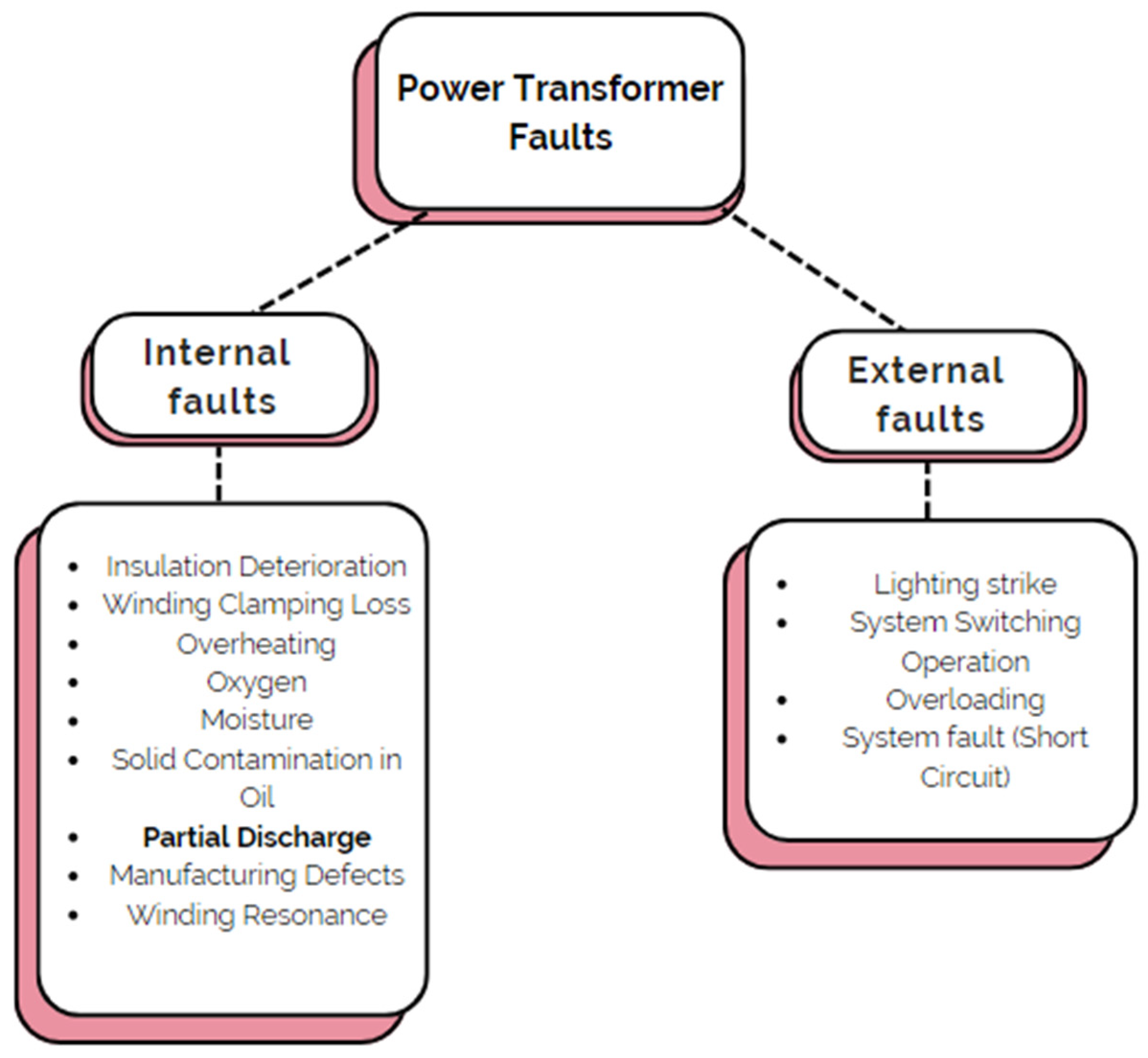
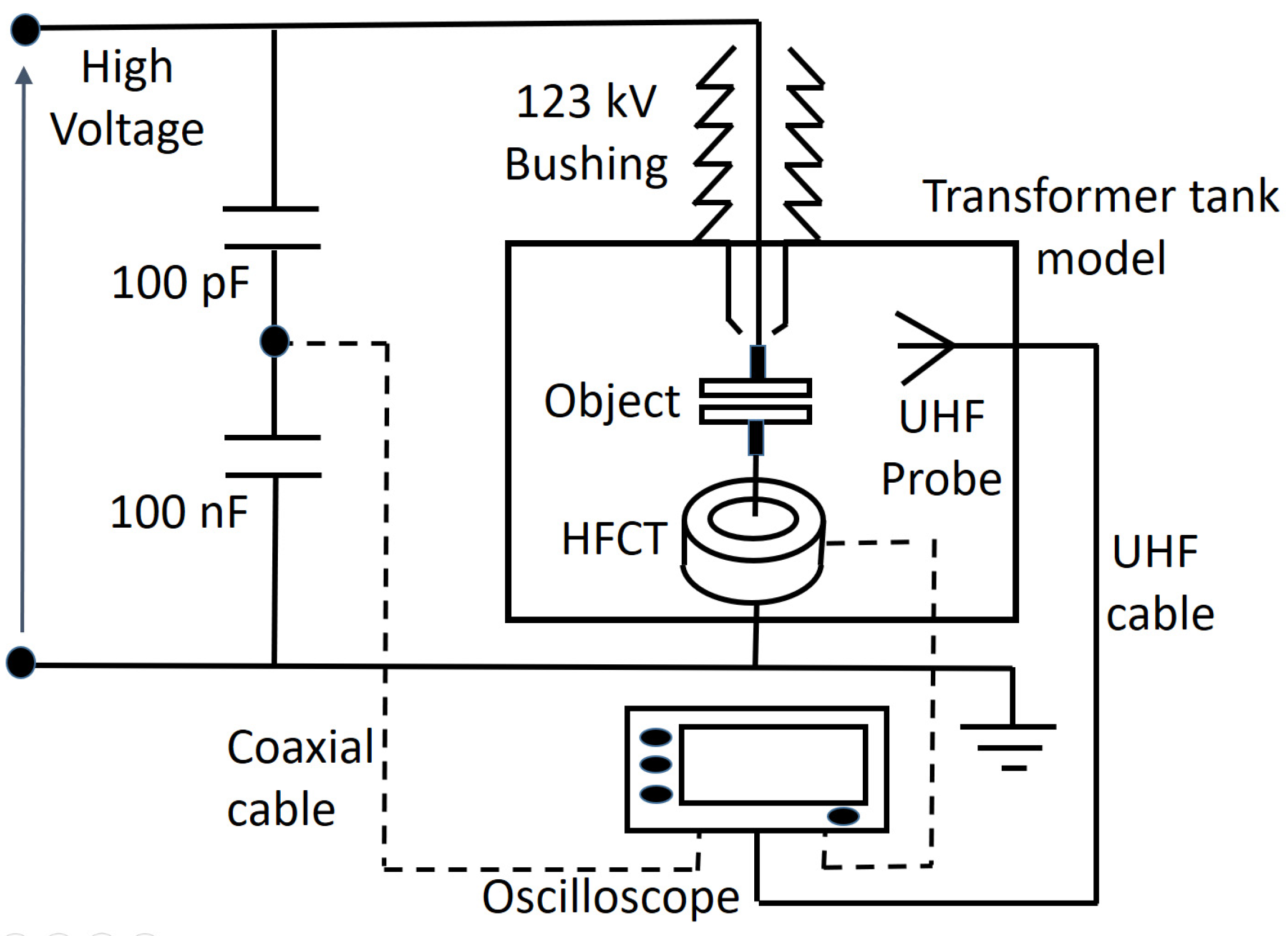

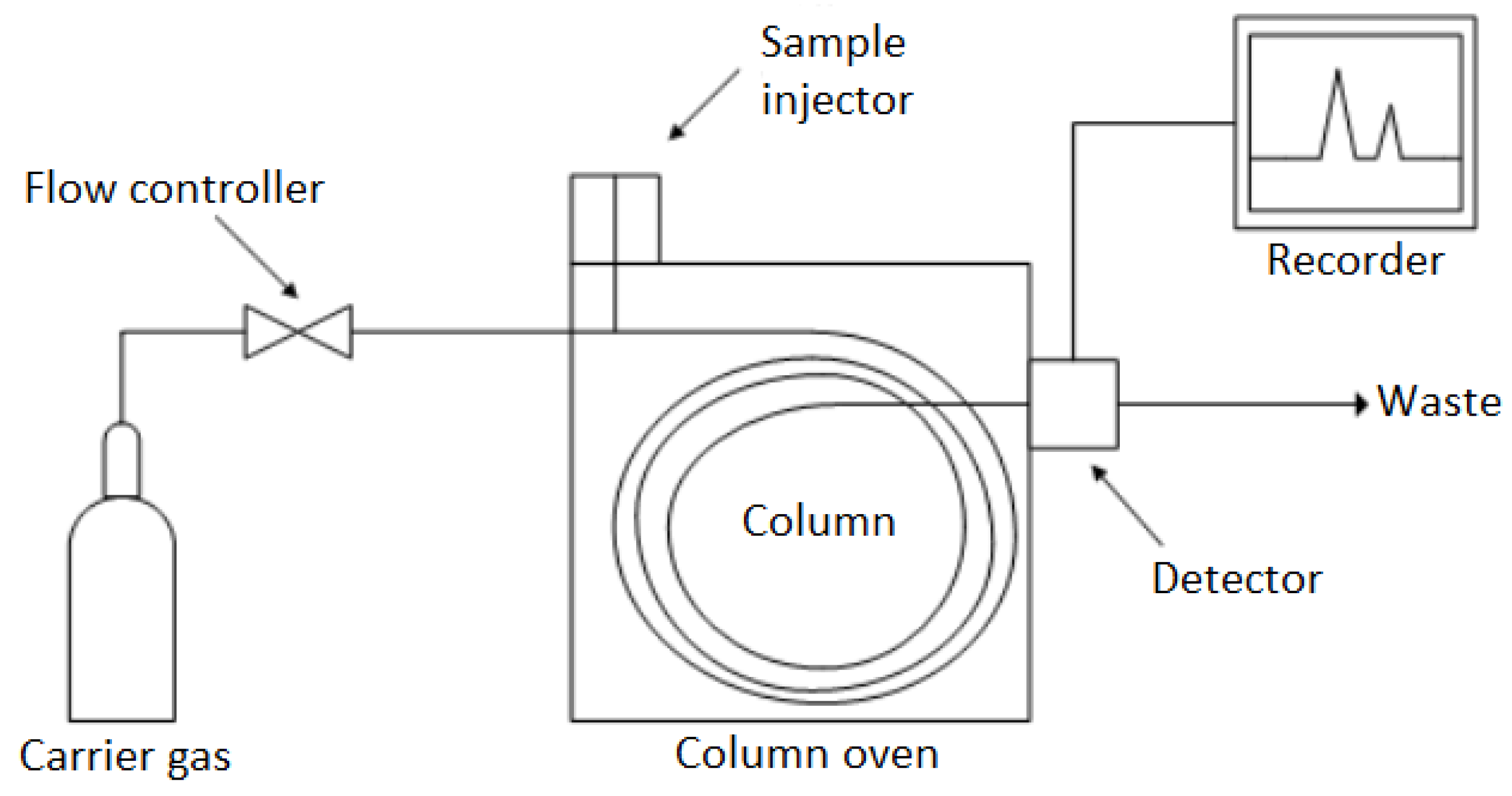
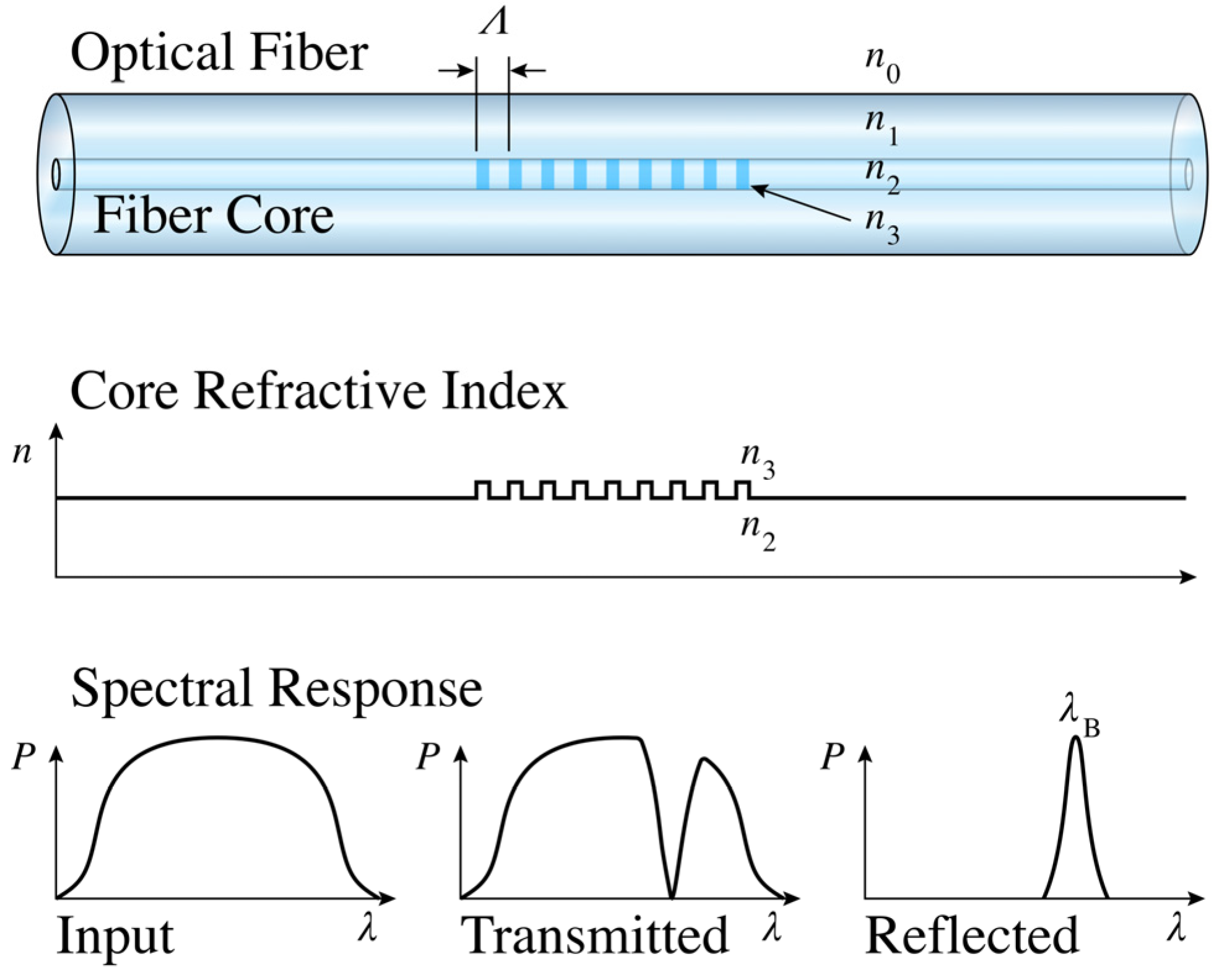
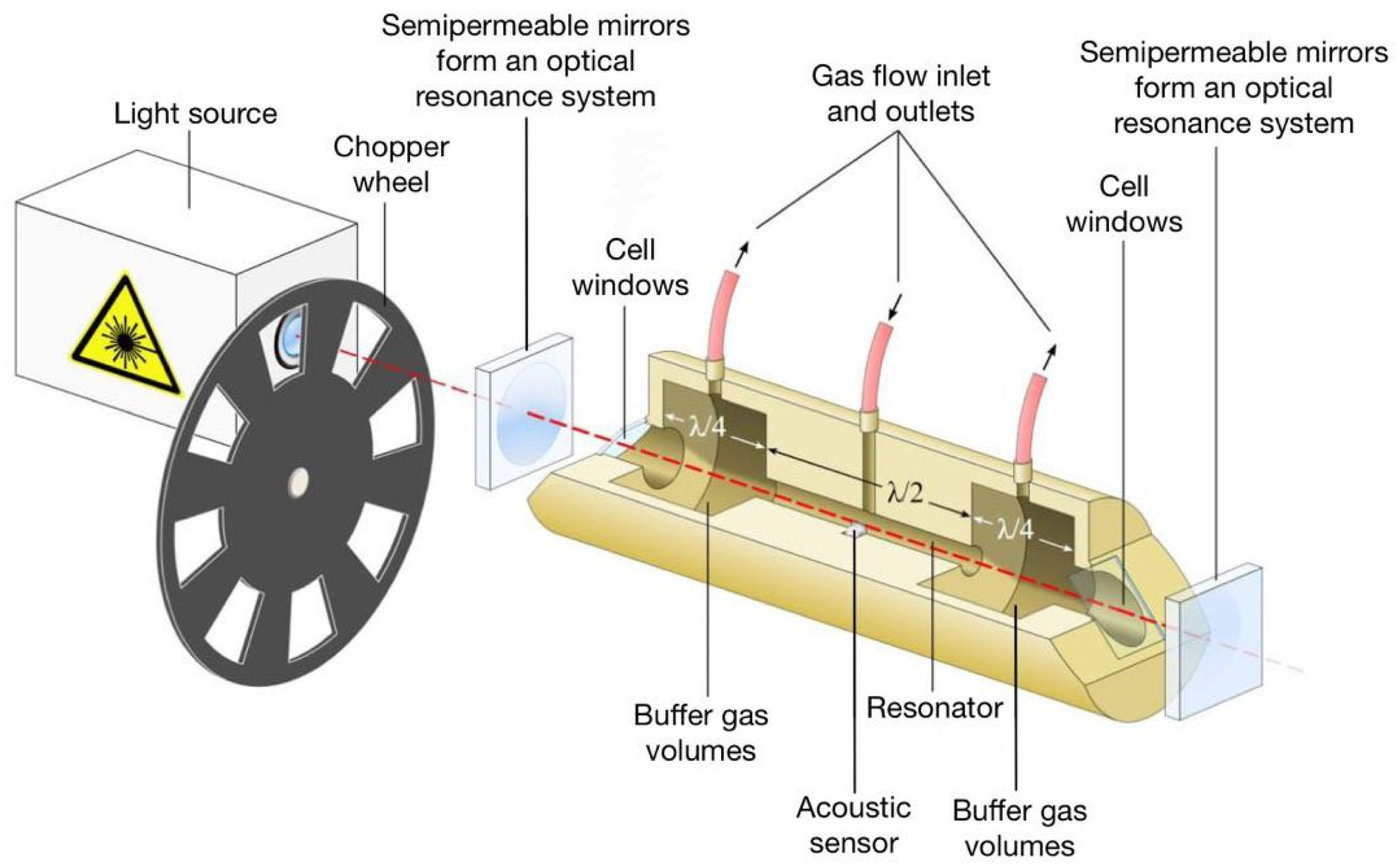



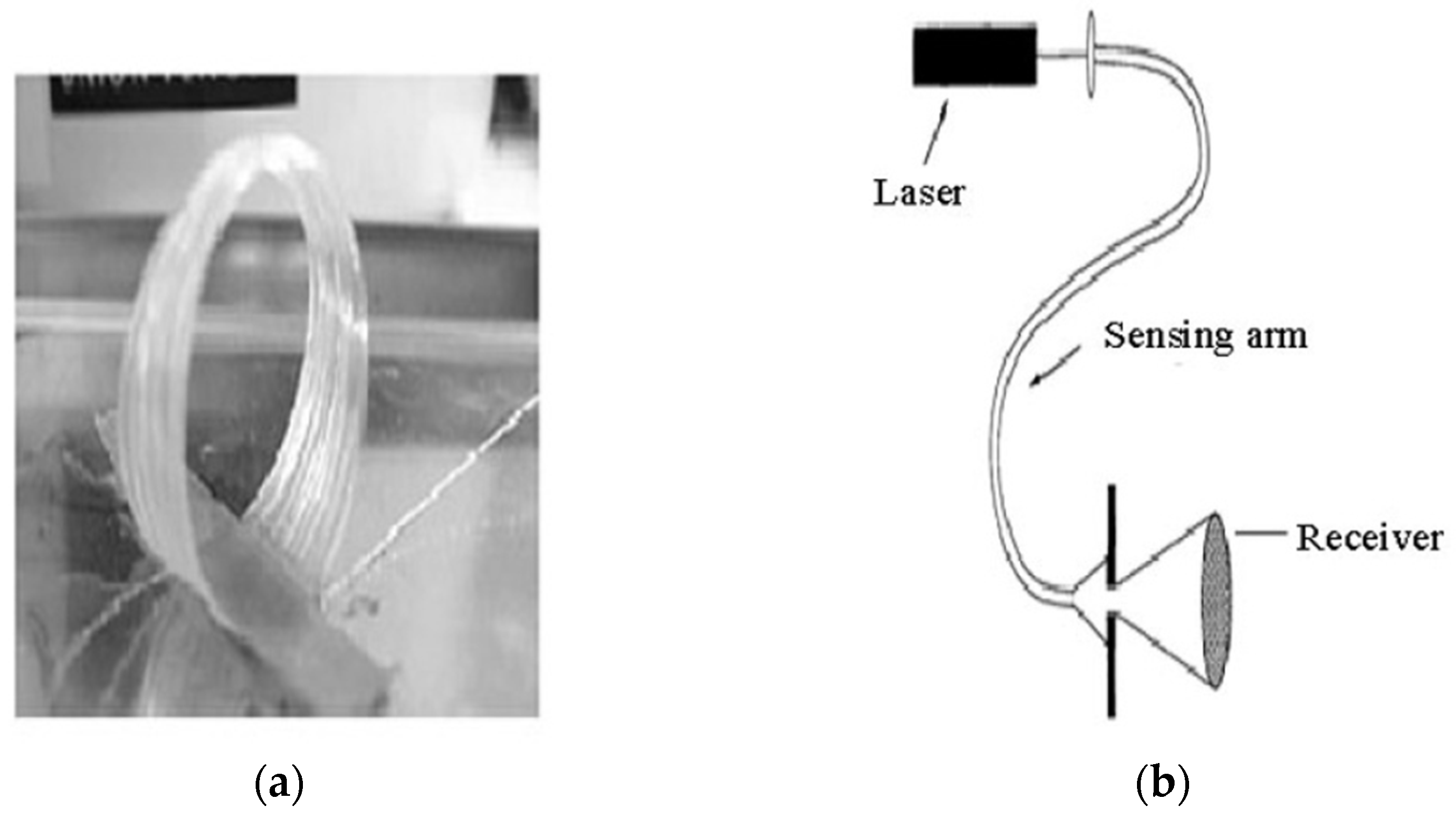

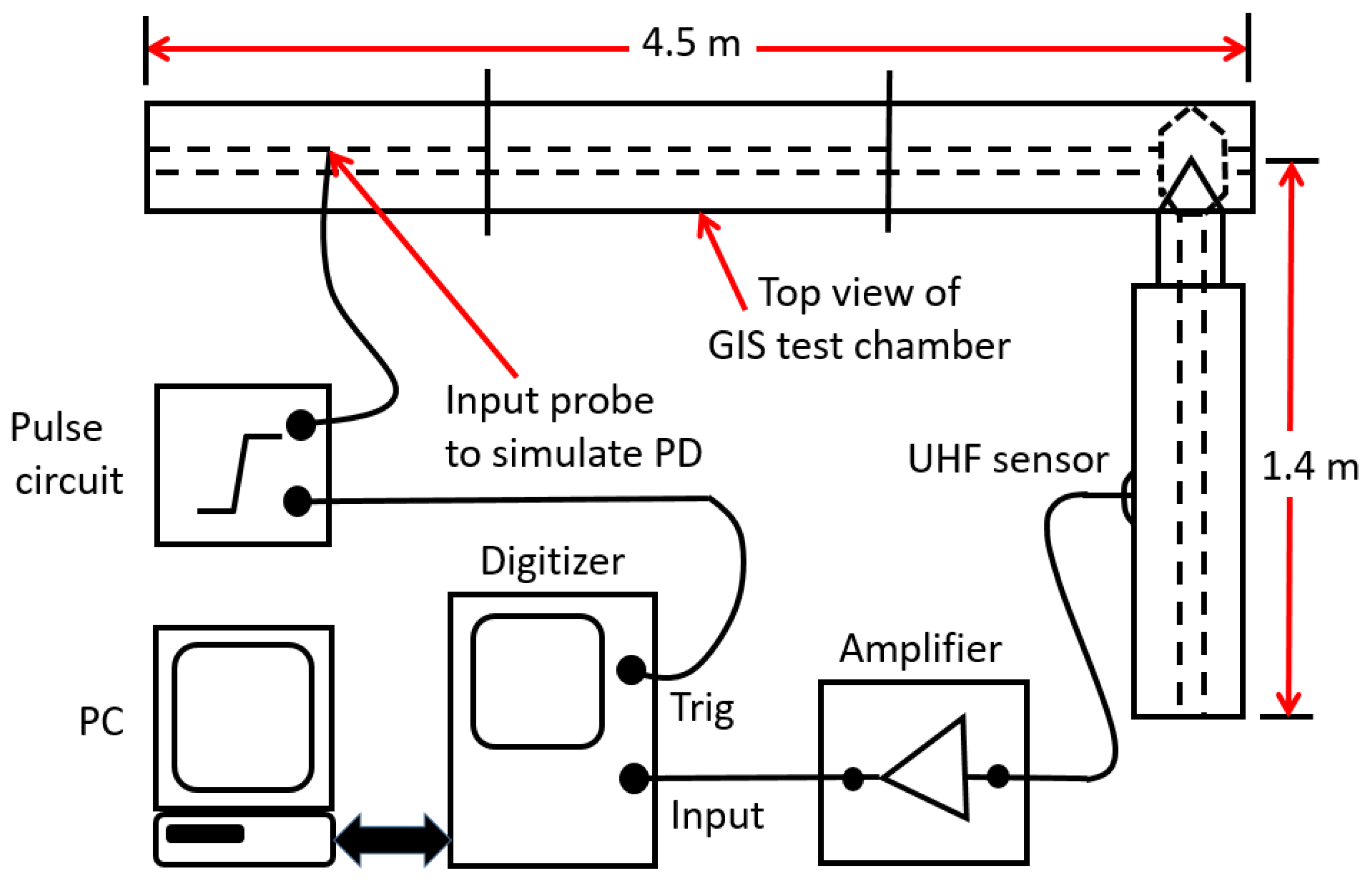
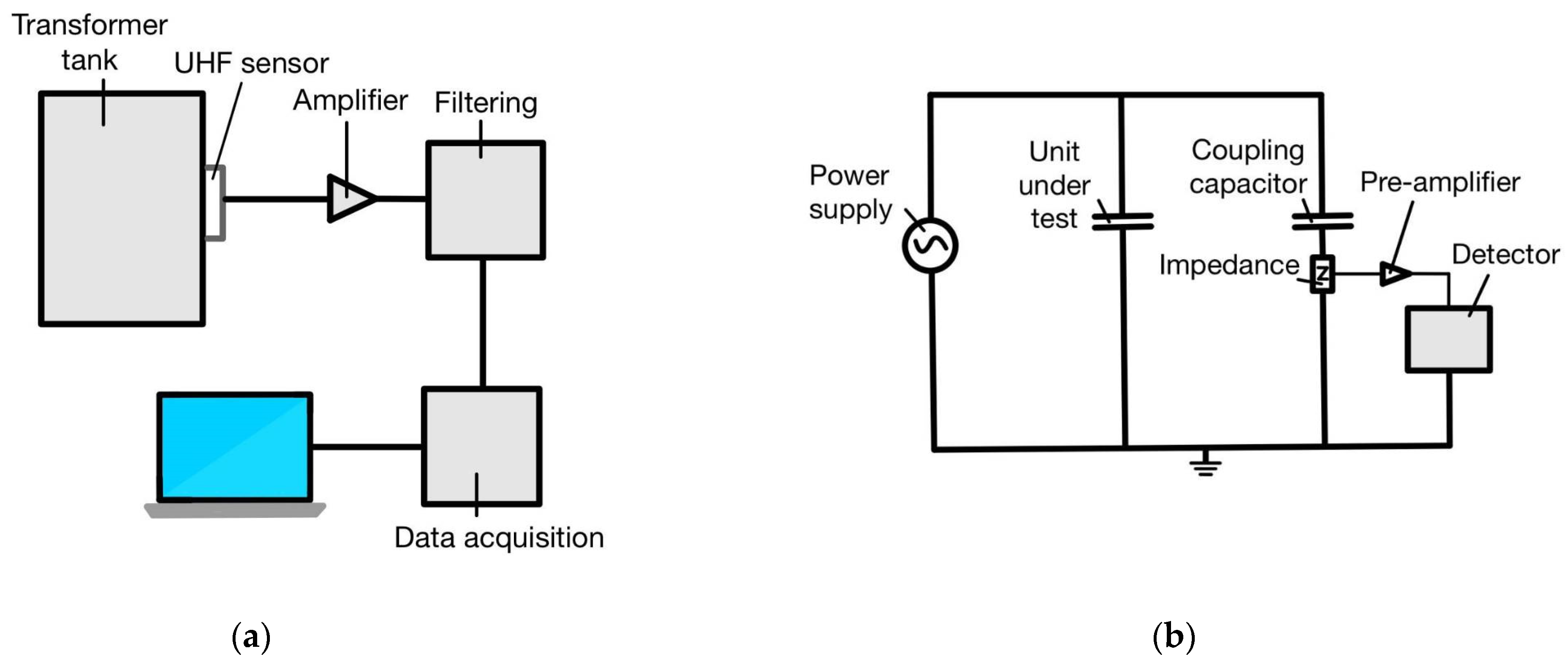
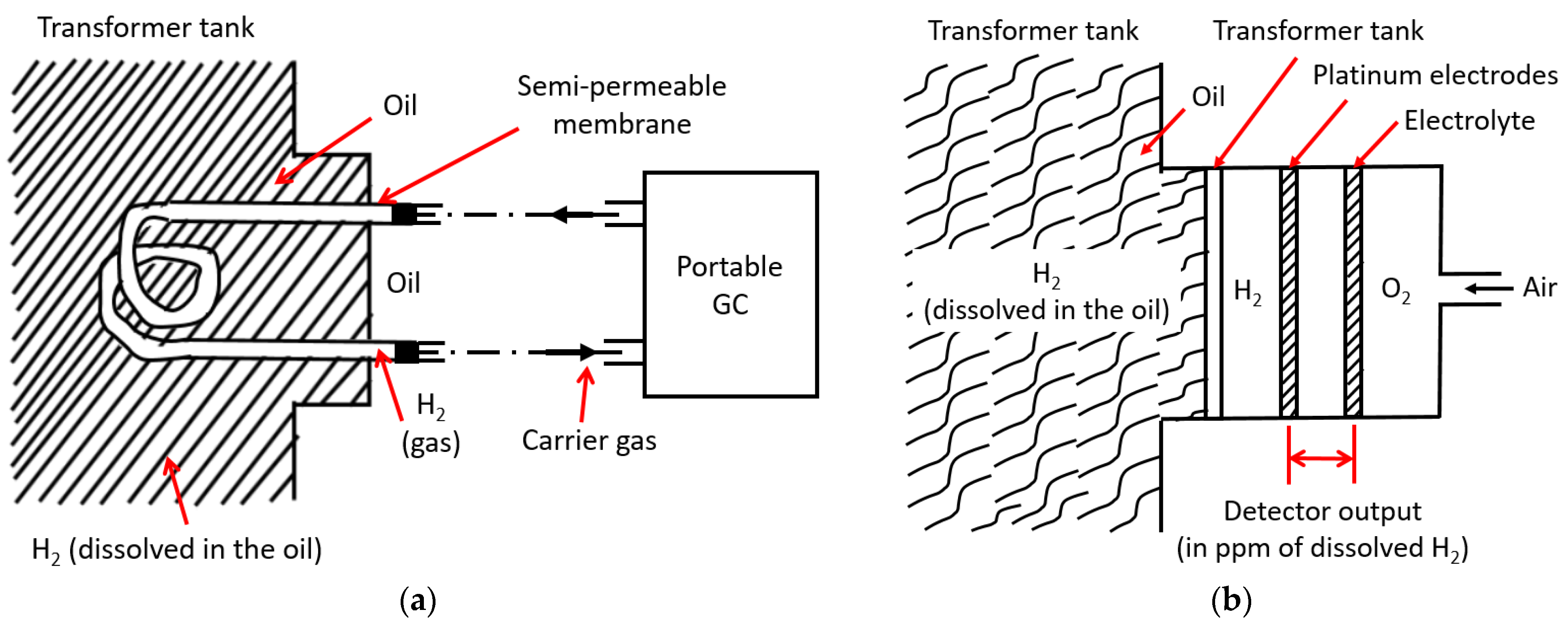
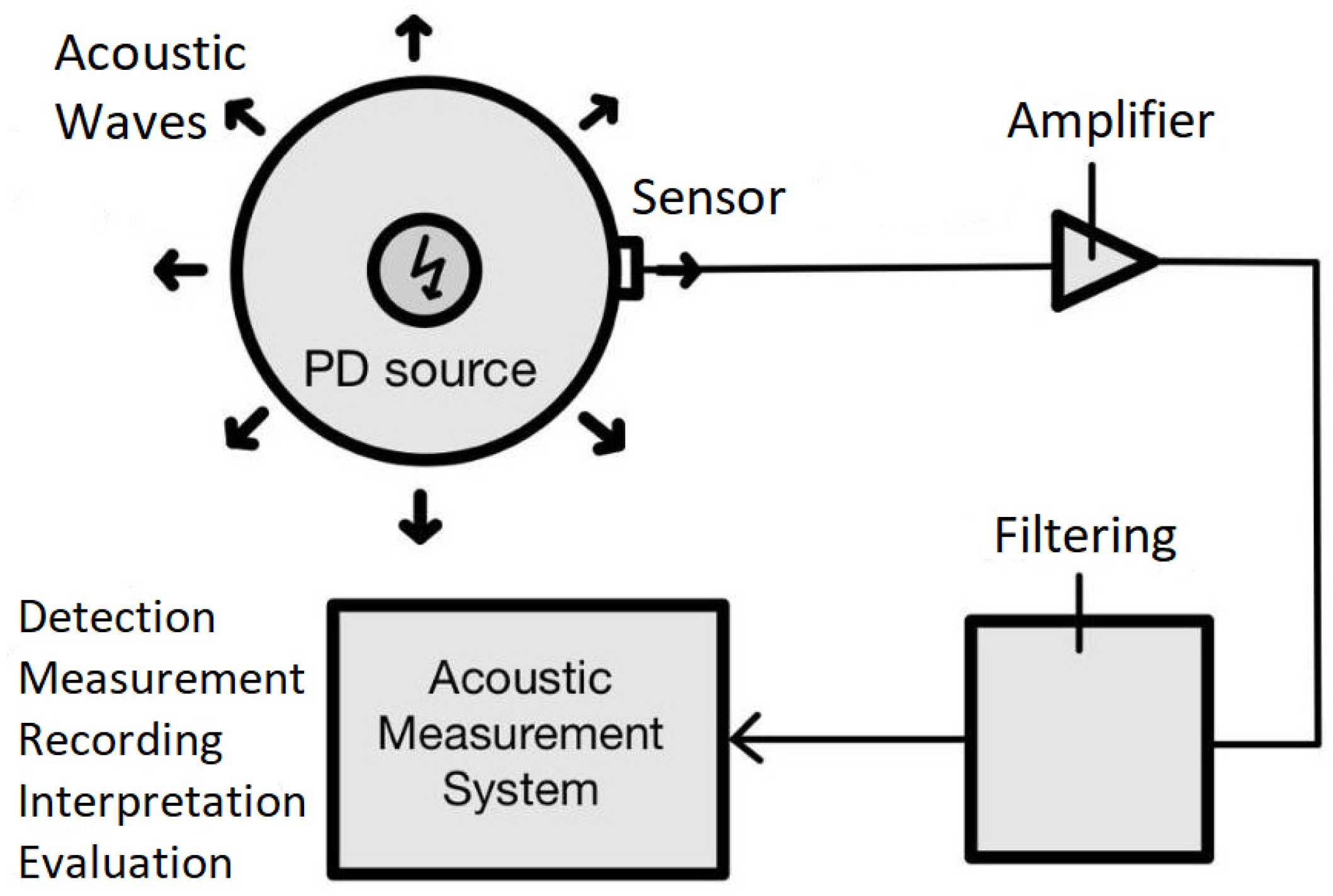
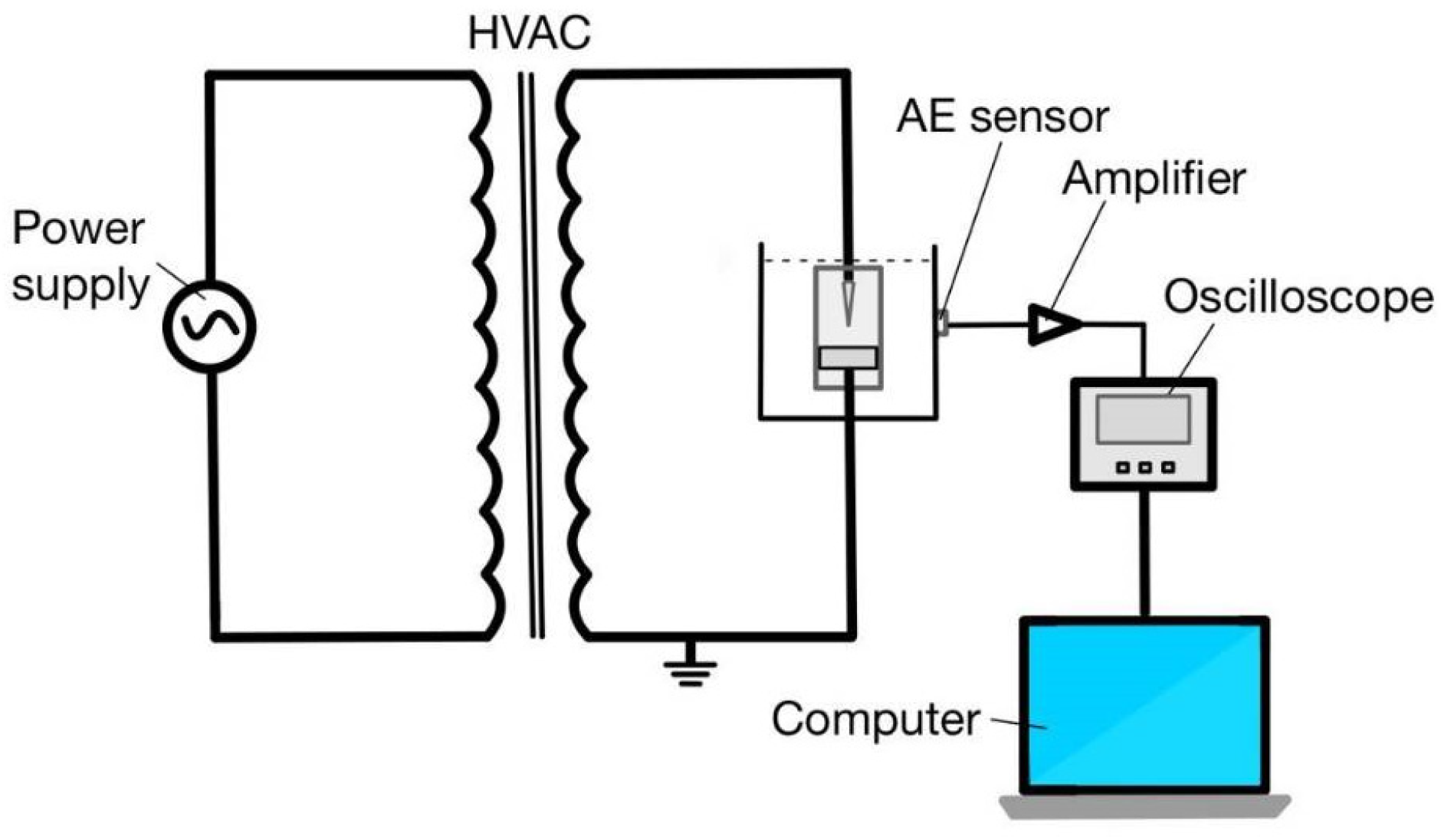
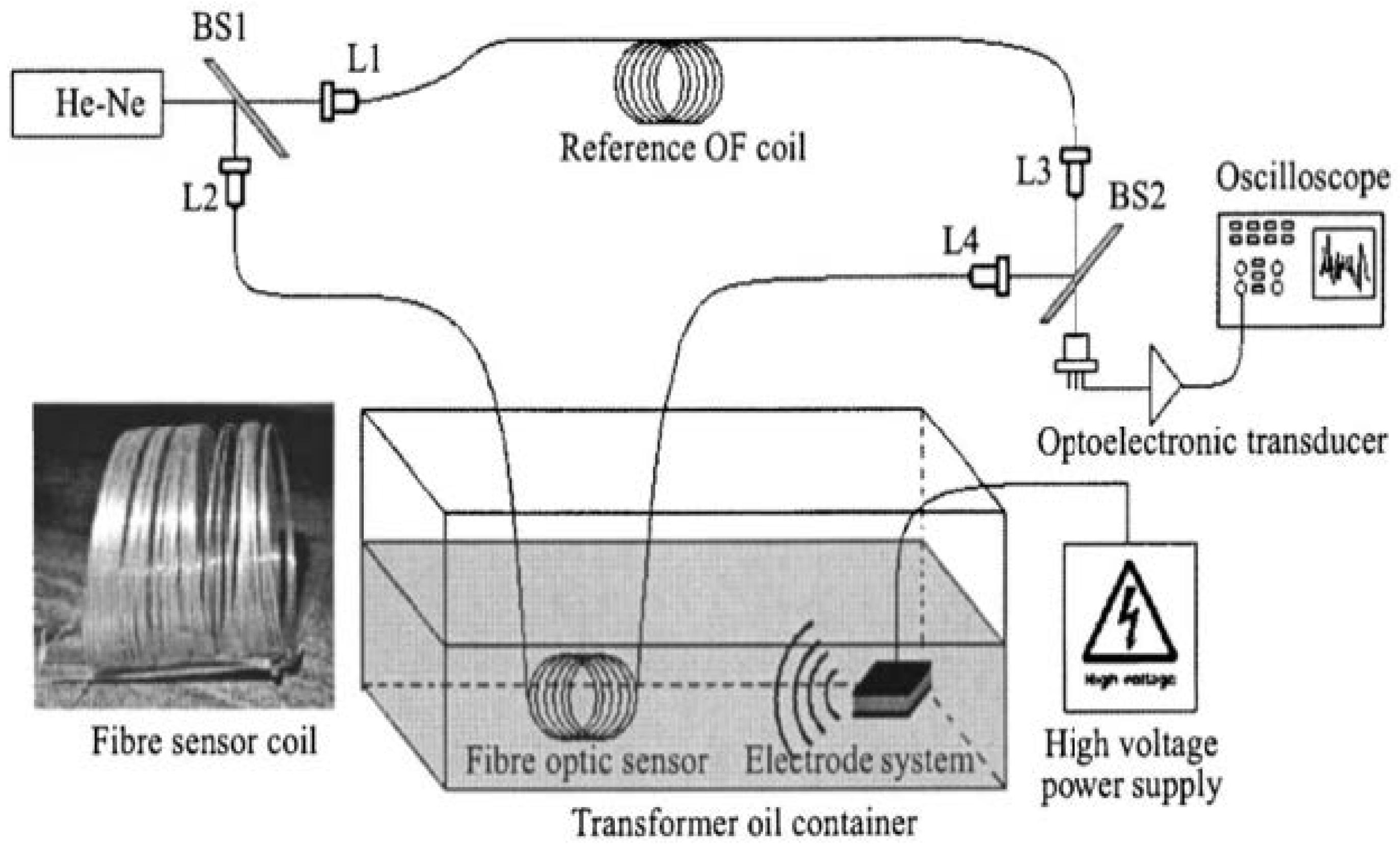

| Electrical Detection [102] | Chemical Detection [103] | Acoustic Detection [104] | Optical Detection [105] | UHF Detection [106] | |
|---|---|---|---|---|---|
| Advantages | High sensitivity to detect low-level PD signals | Good recording of PD signals in the laboratory environment | Non-intrusive technique | High sensitivity to detect low-level PD signals | High sensitivity to detect PD signals |
| Suitable for online monitoring | Suitable for offline analysis and condition assessment | Can be used for offline and online monitoring | Suitable for online monitoring | Suitable for online monitoring | |
| Can be integrated into existing power systems | Provides indirect evidence of PD occurrence | Suitable for large-scale insulation systems | Immune to electromagnetic interference | Can be used for both localized and distributed PD detection | |
| Provides quantitative measurements of PD characteristics | Provides location information of PD sources | Provides spatial information about PD sources | Provides early warning of insulation degradation | ||
| Disadvantages | Affected by noise and interference from the power system | Indirect detection method, limited to specific types of PD | Affected by environmental noise | Limited availability of optical sensors | Affected by environmental noise |
| Require complex signal processing techniques | Requires sampling of insulating oil and gas | Limited sensitivity to detect low-level PD signals | Requires line-of-sight access to the PD location | Signal interpretation may be complex | |
| Requires specialized laboratory equipment | Requires installation of UHF sensors on the equipment |
| Reference, Year | Artificial Defect/PD Test Cell/Electrodes Configuration | Techniques | Significant Outcomes |
|---|---|---|---|
| [128], 2018 | Needle–plane model | A three-phase oil-filled transformer’s whole internal structure was employed to research the propagation properties of electromagnetic waves | The EM signal’s amplitude reduces nonlinearly as its distance from the PD source grows, and the rate of dampening slows as it does so. |
| [45], 2018 | Needle–plane electrode | Transformer oil characteristics for a temperature range of 30–75 °C may be identified via the AE technique | Due to alterations in factors like viscosity and BDV, the AE signal’s amplitude decreased from 65 °C to 75 °C at 17 kV. |
| [129], 2018 | Needle–plane electrode | Fabry–Perot optical fiber sensor array-based AE technique with a steered response power sound-source localization algorithm | Enhanced accurateness compared to the more common piezoelectric transducer. |
| [51], 2019 | Artificial PD defect/source | BA combinational method: the UHF probe’s tip is inserted with an AE sensor | When compared to direct acoustic wave detection, the integrated sensor is more sensitive. |
| [130], 2019 | Water content of transformer insulation paper | Use of optical fiber sensors for optical detection | Ties well to a water activity probe that works with various dielectric oils. |
| [127], 2019 | Void, surface, and floating electrode | When compared to three or more PD sources, the multi-step discrimination approach can detect and differentiate mixed signals with similar forms that the one-step method was unable to do. It can also enhance the differentiation capabilities in subclasses. | |
| [131], 2021 | Suspended metal defect | Use multiplexed optical ultrasonic sensors | Signal processing and analysis techniques were applied to identify partial discharge events. A localization algorithm was likely employed to determine the precise location of the partial discharge within the transformer. The combination of these techniques demonstrates a potential solution for detecting and addressing partial discharge defects in power transformers |
| [132], 2021 | Localized breakdown in electrical insulation | Use high-sensitivity optical fiber interferometer sensor | To enhance the early detection of such defects. |
| [133], 2021 | Localized breakdown in electrical insulation | Use Rogowski coil sensor | Analyzing the time delay between the arrival of PD signals at different locations inside the transformer windings. |
| [134], 2022 | Defect in oil | Acoustic emission technique | The use of fuzzy logic aids in approaching acoustic emission technique for PD detection. |
| Reference, Year | Artificial Defect/PD Test Cell/Electrodes Configuration | Techniques | Significant Outcomes |
|---|---|---|---|
| [135], 2018 | Voids and containments | Integration of optical fiber and ultra high frequency (UHF) | Usage of both methods at once provides comprehensive approach to PD detection. |
| [136], 2018 | Conductor protrusions | Power-frequency partial discharge test | The test asses the dielectric integrity of GIS equipment by detecting weak discharge under AC voltage. |
| [137], 2018 | Free-moving particles, protrusions, floating metallic parts, as well as cavities due to voids and cracks in spacers | Uses ultra-high-frequency (UHF) for PD measurement | A new approach to diagnosing unknown phase-shifted PDs in GIS using a decision tree method, based on UHF measurement and extracted parameters, |
| [138], 2019 | Voids, impurities, or mechanical stresses | Employing an optical fiber sensor | Optical fiber sensor technique offers advantages such as high sensitivity, immunity to electromagnetic interference, and the ability to perform remote monitoring of PD activity in GIS. |
| [139], 2020 | Cracks, floating particles, free particles, protrusions on conductors (POC), protrusions on enclosures (POE), particles on spacers (POS), and voids | Use autoencoders | Aims to identify and classify these PD defects in GISs. |
| [140], 2021 | Fault diagnosis of gas-insulated switchgear (GIS) | Micro built-in optical sensor along with a UHF (ultra high frequency) | These techniques enhance the accuracy and effectiveness of PD fault diagnosis in GIS equipment. |
| [141], 2021 | Insulation degradation, equipment failure | Fluorescent optical fiber sensor | Offers the advantage of non-invasive and real-time monitoring, which can help in identifying and addressing potential insulation problems before they escalate into major failures. |
| [142], 2022 | Latent insulation fault | Ultra-high-frequency (UHF) flexible planar biconical antennas | New flexible planar biconical antenna design method for PD detection in GIS. This technique offers improved detection sensitivity and adapts to the curved structure of GIS. |
| [143], 2022 | Insulation voids | Multiscale fusion simulation | Involves the use of a numerical model based on the Finite Element Method (FEM). The FEM model considers the complex structure and material properties of the GIS, including the insulation void defects. |
| [144], 2022 | Corona discharge | UV sensors | A new method for detecting corona discharge in Gas Insulated Switchgear based on UV light emissions. The technique offers non-intrusive and real-time monitoring capabilities, enabling timely detection and maintenance actions to ensure the reliable operation of GIS systems. |
Disclaimer/Publisher’s Note: The statements, opinions and data contained in all publications are solely those of the individual author(s) and contributor(s) and not of MDPI and/or the editor(s). MDPI and/or the editor(s) disclaim responsibility for any injury to people or property resulting from any ideas, methods, instructions or products referred to in the content. |
© 2023 by the authors. Licensee MDPI, Basel, Switzerland. This article is an open access article distributed under the terms and conditions of the Creative Commons Attribution (CC BY) license (https://creativecommons.org/licenses/by/4.0/).
Share and Cite
Faizol, Z.; Zubir, F.; Saman, N.M.; Ahmad, M.H.; Rahim, M.K.A.; Ayop, O.; Jusoh, M.; Majid, H.A.; Yusoff, Z. Detection Method of Partial Discharge on Transformer and Gas-Insulated Switchgear: A Review. Appl. Sci. 2023, 13, 9605. https://doi.org/10.3390/app13179605
Faizol Z, Zubir F, Saman NM, Ahmad MH, Rahim MKA, Ayop O, Jusoh M, Majid HA, Yusoff Z. Detection Method of Partial Discharge on Transformer and Gas-Insulated Switchgear: A Review. Applied Sciences. 2023; 13(17):9605. https://doi.org/10.3390/app13179605
Chicago/Turabian StyleFaizol, Zulbirri, Farid Zubir, Norhafezaidi Mat Saman, Mohd Hafizi Ahmad, Mohamad Kamal A. Rahim, Osman Ayop, Muzammil Jusoh, Huda A. Majid, and Zubaida Yusoff. 2023. "Detection Method of Partial Discharge on Transformer and Gas-Insulated Switchgear: A Review" Applied Sciences 13, no. 17: 9605. https://doi.org/10.3390/app13179605
APA StyleFaizol, Z., Zubir, F., Saman, N. M., Ahmad, M. H., Rahim, M. K. A., Ayop, O., Jusoh, M., Majid, H. A., & Yusoff, Z. (2023). Detection Method of Partial Discharge on Transformer and Gas-Insulated Switchgear: A Review. Applied Sciences, 13(17), 9605. https://doi.org/10.3390/app13179605









